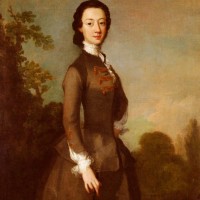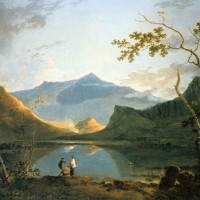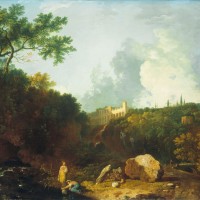| Painting Name | A Capriccio Landscape With The Temple Of The Sibyl At Tivoli And The Broken Bridge At Narni |
| Painter Name | Richard Wilson |
| Completion Date | 1755 |
| Place of Creation | Italy, Narni |
| Size | 134.9 x 96.5 cm (4' 5.11" x 3' 1.99") |
| Technique | Oil |
| Material | Canvas |
| Current Location | Private collection |
Modern time filled with high-budget movies with special effects, we often forget that imagination and fantasy was not invented in modern time. It was sprouted in a human mind as soon as a human started ‘rational thinking’. Fantasy is a state where everything is possible and everything is allowed. When an artist mixes his fantasy and reality, he conjures up something which is totally unprecedented. Here, I see such combination of reality and fantasy by the Welsh painter Richard Wilson.
Here, as the title says, is a capriccio painting bringing two different places at one. In art, capriccio means a painting which consist the combination of fictional or real architecture and buildings. Thus, they are partly real but don’t exist in real world as a whole.
The presented warm landscape combines two historical places at one place: The Temple of Sibyl at Tivoli & The Broken Bridge at Narni. Both monuments are filled with antique significance. The temple of Sibyl, Italy is a roman temple from 1st century BC not sure attributed to which god or goddess.
The second architecture is The Broken Bridge of Narni. In reality, the bridge is well-known because of its size. It was the largest roman bridge ever built in its time on the river Nera. Even today, some of its remains still stand strong at the real site.
Artist have brought both history-loaded monuments at singled place with such a beauty that a person unknown to the fact would consider it as a real place.
The art-piece could also be called as a Staffage, due to the trivial inclusion of the people in the scenery. Staffage means a landscape consisting humans but are not the primary subjects of the entire scene.
In foreground of the painting, without significant focus on them a group of people and a herd of cows, sheep and donkeys portrayed in front of another monument’s remains. They seem to be travelers or villagers on the way and are involved in routine works. In the painting, they are just adding up a human-feeling, whereas the main focus stays on the landscape’s beauty. For such beautiful depictions, oil and canvas is the perfect match which doesn’t restrict the painting in anyways.




